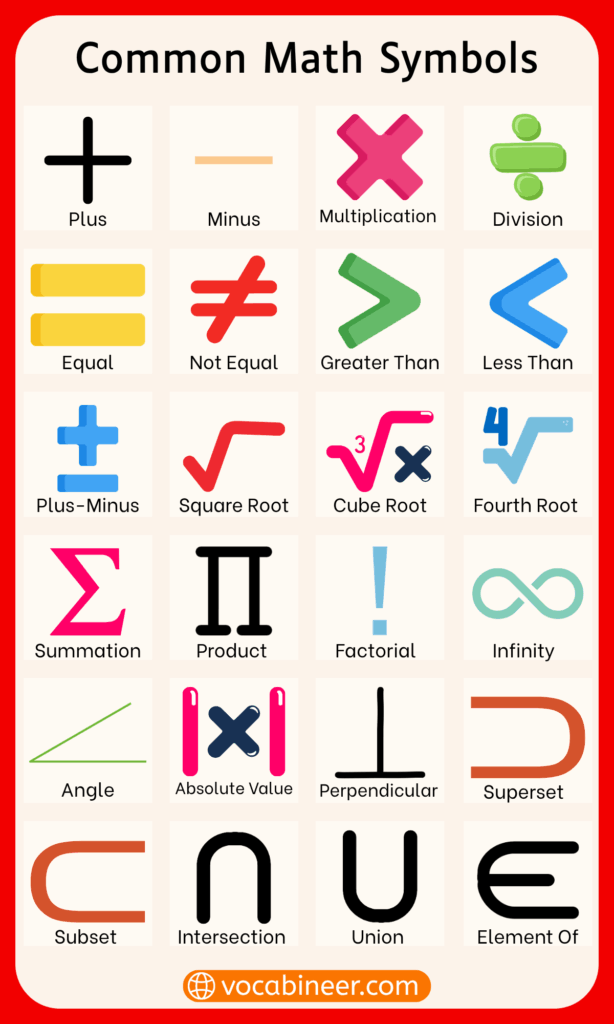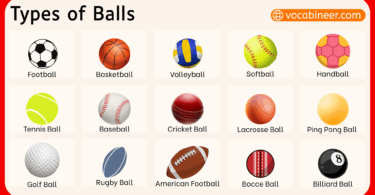Math symbols appear in every part of learning — from basic sums to advanced equations. Knowing their names and meanings in English helps students and ESL learners follow instructions, solve problems, and read math more confidently. This guide includes key math symbols with pictures, grouped by topic like arithmetic, algebra, geometry, and comparisons. These small signs carry powerful meanings — and once you learn them, math gets easier to understand.
In This Page
All Mathematical Symbols with Name
Here is a complete list of mathematical symbols with their names to help students and ESL learners recognize and use them correctly.
+→ Plus–→ Minus×→ Multiplication÷→ Division=→ Equals≠→ Not Equal±→ Plus-Minus≈→ Approximately Equal≡→ Identical To>→ Greater Than<→ Less Than≥→ Greater Than or Equal≤→ Less Than or Equalx, y, z→ Variables√→ Square Root∛→ Cube Root∑→ Summation∏→ Product (capital pi)|x|→ Absolute Value∞→ Infinity∝→ Proportional To∠→ Angle°→ Degree⊥→ Perpendicular∥→ ParallelΔ→ Triangleπ→ Pi⊙→ Circle Symbol∅→ Empty Set (used in geometry and sets){ }→ Set Brackets∈→ Element Of∉→ Not an Element Of⊂→ Subset⊃→ Superset∩→ Intersection∪→ Union¬→ Not∧→ And∨→ Or⇒→ Implies⇔→ If and Only If/→ Fraction Slash.→ Decimal Point%→ Percent‰→ Per Mille→→ Right Arrow (used in steps)←→ Left Arrow∴→ Therefore∵→ Because…→ Ellipsis (used in sequences)#→ Number Sign

Basic Math Signs and Their Uses for Beginners
These math signs are used in early lessons and daily calculations. They help with adding, subtracting, multiplying, and dividing numbers.
- + (Plus Sign) – Used to add two or more numbers.
Example: 4 + 3 = 7 - – (Minus Sign) – Used to subtract one number from another.
Example: 9 – 5 = 4 - × (Multiplication Sign) – Means “times” or repeated addition.
Example: 6 × 2 = 12 - ÷ (Division Sign) – Shows sharing or splitting equally.
Example: 8 ÷ 4 = 2 - = (Equals Sign) – Used to show that both sides are the same.
Example: 5 + 1 = 6 - ≠ (Not Equal To) – Means the two sides are not the same.
Example: 3 + 3 ≠ 10
Algebra Symbols and Operations Vocabulary List
These symbols are common in algebra problems and equations:
- x, y, z – variables used to represent unknown numbers
- = (Equal Sign) – used to balance equations: x + 2 = 5
- ≠ (Not Equal To) – shows two sides are not the same
- > (Greater Than) – means left side is more: x > 3
- < (Less Than) – means left side is less: x < 7
- ≥ (Greater Than or Equal To) – x ≥ 10 means x is 10 or more
- ≤ (Less Than or Equal To) – x ≤ 5 means x is 5 or less
- ± (Plus-Minus Sign) – used in roots: ±3 means +3 and –3
- √ (Square Root) – root of a number: √9 = 3
- ∑ (Sigma) – summation symbol in advanced algebra
Geometry Symbols Names with Shapes and Meanings
Geometry symbols help describe shapes, angles, and figures:
- ° (Degree Symbol) – used to measure angles: 90°
- ∠ (Angle Sign) – shows a specific angle: ∠ABC
- ⊥ (Perpendicular Symbol) – two lines at 90°: AB ⊥ CD
- ∥ (Parallel Symbol) – two lines never meet: AB ∥ CD
- Δ (Triangle Symbol) – used to show triangles: ΔABC
- π (Pi Symbol) – value of 3.141… used in circles
- r – radius of a circle
- d – diameter of a circle
- ⊙ (Circle Symbol) – shows a circle shape
Fractions, Decimals, and Percentage Symbols Explained
These symbols are used when working with parts, money, or percentages:
- ½, ¼, ¾ – common fraction symbols
- / (Slash) – used to show a fraction: 3/5
- % (Percent Sign) – means “per hundred”: 50% = half
- . (Decimal Point) – separates whole and fractional part: 3.5
- ‰ (Per Mille) – means per thousand: 25‰ = 0.025
- ∞ (Infinity Symbol) – something with no end
Greater Than, Less Than, and Equality Symbols
These comparison symbols are used to show how numbers relate:
- = (Equals) – both values are the same
- ≠ (Not Equal) – values are not the same
- > (Greater Than) – more than
- < (Less Than) – less than
- ≥ (Greater Than or Equal) – more than or same
- ≤ (Less Than or Equal) – less than or same
- ≈ (Approximately Equal) – nearly the same
- ≡ (Identical To) – completely equal in value and form
Common Math Symbols in Exams and School Textbooks
These symbols appear often in school worksheets, textbooks, and exams:
- → (Right Arrow) – shows steps in solving
- ∴ (Therefore Symbol) – used in logical steps
- ∵ (Because Symbol) – used to explain reasons
- ≅ (Congruent Symbol) – shapes are the same in size and angle
- ∝ (Proportional To) – a is proportional to b: a ∝ b
- |x| (Absolute Value) – distance from zero: |–4| = 4
FAQs About Math Symbols
+ – × ÷ are the four basic arithmetic symbols.
It means the values on both sides are the same.
The ∞ symbol is used to show something that has no limit or end.
Yes. ≈ means approximately equal, not exact. = means exactly equal.
It refers to an angle formed by the points A, B, and C, with B as the vertex.
Read More




